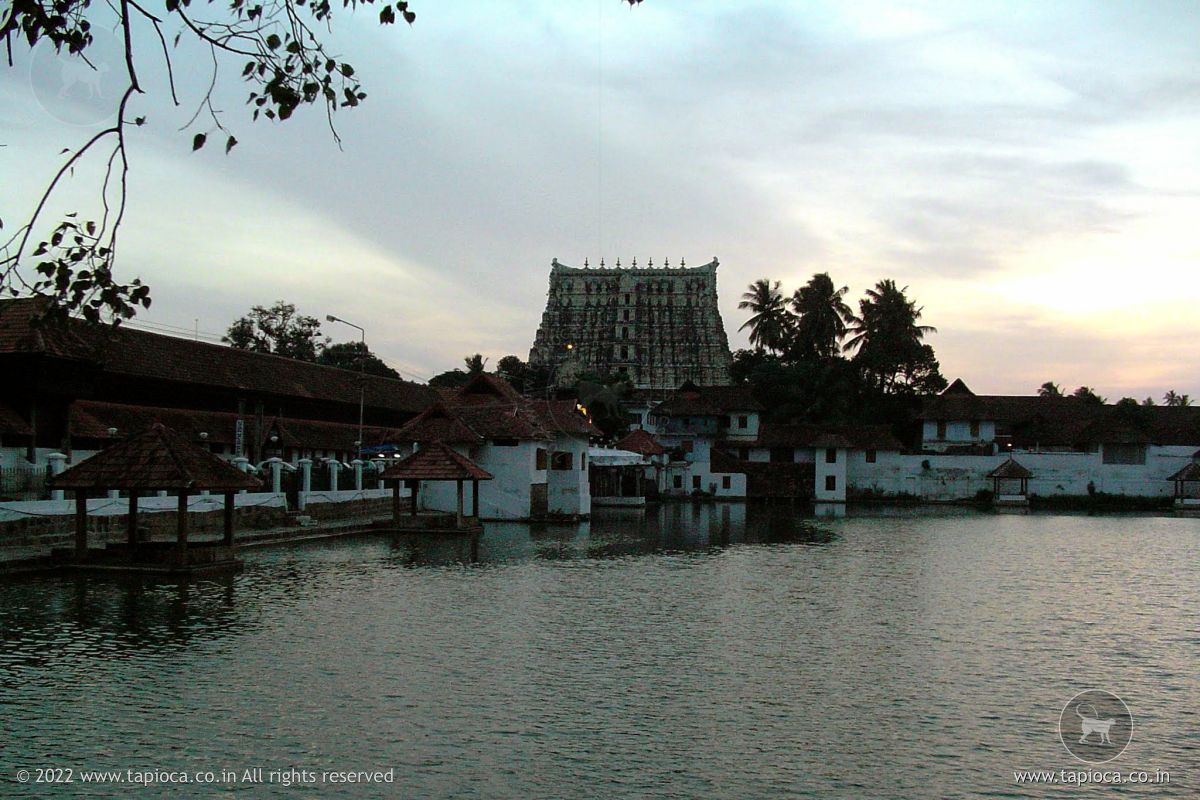Sree Padmanabhaswamy Temple in Thiruvananthapuram
Major attractions inside Thiruvananthapuram's Padmanabhaswamy Temple

Thiruvananthapuram
Padmanabha Temple and the Temple Tank in the Evening
Why Sree Padmanabhaswamy Temple is called a Maha Kshetram (Great Temple)?
Apart from the obvious accepted spiritual aspects, Sree Padmanabhaswamy Temple has many factors that elevates itself to a great temple.
Antiquity This temple has at least recorded antiquity from 8th century.
Records & Literature This temple has its own records from palm leaf documents to other forms of records noting the major events associated with the temple. Major ancient literature, Epics and sacred texts has mention of this temple.
History Padmanabhaswamy Temple's history is woven with the history of Travancore kingdom. The ruling royals of Travancore kingdom is intrinsically connected with Sree Padmanabhaswamy Temple.
Nature The origin of the Temple in an erstwhile forested area. The place is very close to the seaside. The temples location together with in geographic backdrop is significant for a spiritual center.
ArchitectureThe architecture is this Padmanabhaswamy Temple both magnificent and unique. Originally temple interior was executed in the classic Kerala style architecture, while the imposing facade, the temple tower was later added in Chola style architecture from the tamil country.
Festivals This temple is known for fabzulous festivals with pomp and grandeur. Also large cultural and artistic performances are associated with the annual festival of this temple.
Wealth This is one of the richest living temples in the world. The relatively recent discovery of treasures in the temple attracted the attention of both devotees and general tourists to the temple.
Ananthasayanam Idol
It is believed that twelve Salagramas stones, when worshipped together gain the potency of a Mahakshetram (Great Temple).
T
he Idol of Sree Padmanabha Swamy is made up of twelve thousand and eight (12008) Salagramas and a herbal compound called 'Katusarkara yogam'. This ayurvedic compound contains 108 elements brought from all over India.Salagramas were collected & brought from the Gandaki Riverbed in Nepal. Salagramas represent Maha Vishnu. This Temple gains the greatness and sanctity of a thousand great temples.
Inside the shrine , Lord Padmanabha reclines on the serpent Anantha or Adi Sesha. The serpent has five hoods facing inwards, signifying contemplation. The Lord's right hand is placed over a Shiva lingam.
Sridevi-Lakshmi, the Goddess of Prosperity and Bhudevi the Goddess of Earth, two consorts of Vishnu are by his side.
Brahma seated on a lotus emanating from the Lord's navel. The name Padmanabha is associated with this aspect of Vishnu. 'Padma' means, lotus and 'nabha' denotes navel.
Shiva
It's rare to see Lord Shiva idol inside a Vishnu Temple or vice versa. The presence of Shiva within the sacrum santorum adds significance of the Padmanabhaswamy Temple.
Many other areas of the Temple are adorned with the images of Lord Shiva.
Ottakkal Mandapam
The Ottakkal Mandapam in malayalam literally translates to platform with a monolithic slab (single stone ). The Mandapam (pavilion) is in front of the sanctum sanctorum of Lord Sree Padmanabhaswamy. The slab of granite is two and a half feet thick and twenty feet square.
The Abhishekams to Sree Padmanabhaswamy are performed in this Mandapam. The granite pillars of Ottakkal Mandapam are covered with gold.
Only the King of Travancore may prostrate on the "Ottakkal Mandapam".
It is traditionally held that anybody who prostrates on the mandapam has surrendered all that he possesses to the Deity. Since the ruler has already done that, he is permitted to prostrate on this mandapam.
Three Doors of the Sreekovil
The Sreekovil ( sanctum Sanctorum) of Padmanabhaswamy has three doors, all facing the east. From outside, no one can see the idol in full length. The deity is visible through three doors.
First Door: The visage of the reclining Lord and Siva Linga underneath his hand is seen through the first door;
Second Door:Sridevi and Bhrigu Muni, Brahma seated on a lotus emanating from the Lord's navel, gold abhisheka moorthies of Padmanabha, Sridevi and Bhudevi, and silver utsava moorthy of Padmanabha is seen through the second door.
Third Door: Lord's feet, and Bhudevi and Markandeya Muni through the third door.
The idols of two goddesses holding chamaram, Garuda, Narada, Tumburu, the divine forms of the six weapons of Vishnu, Surya, Chandra, the Saptarshi, Madhu, and Kaitabha are also in the Sanctum.
Abhisravana Mandapam
This structure is in front of the Ottakkal Mandapam but outside the Cherruchuttu containing the sanctum sanctorum. Special poojas related with Temple festivals are performed here. Devotees use this Mandapam for meditation and prayer.
Kulasekhara Mandapam
This is an architecturally thrilling pavilion made of granite.
This pavilion is also known as Aayiram Kaal Mandapam ('Thousand Stone Pavilion ') and Saptaswara Mandapam ('Seven Musical Notes Pavilion').
The pavilion is supported by by 28 balustrades of pillars. The pillars on the four corners can produce musical notes when tapped. The pillars are adorned with exquisitely carved figures in half and full relief.
Apart from Kulasekhara Mandapam & Abhisravana Mandapam, there are 9 other mandapams in the Temple. And 8 mandapams are around the Padmatheertham pond.
Dhwaja Stambham
An eighty feet high flagstaff near the eastern corridor was installed by Anizham Thirunal in 1730 AD. A teak wood pole for its construction was carried from the nearby forest to the Temple. As per Shastras the wood should not touch the ground while in transport. It was brought so for the installation.
The teak pole is covered with gold plate. The apex of the Dhwaja Stambham has a figure of Garuda, in kneeling posture, facing Lord Vishnu.
Nine Entrances
Padmanabhaswamy Temple has nine entrances, denoting the nine orifices of the human body. The primary entrance through the east, through the imposing Gopuram.
Gopuram
The Temple has a seven storeyed Chola style Gopuram built on the eastern entrance. This stucco filled structure is a fine example of Chola architecture, exclusively used Dravidian temples.
The Gopuram is about 35m heigh. On the top there are 7 golden domes suggesting pointers to the seven Worlds.
The 10 incarnations of Lord Vishnu are portrayed inside the first storey of the Gopuram.
The other three entrances are double storied Padippura (doorways) in typical Kerala Style.
Arguably this Gopuram is the most photographed backdrop of Padmanabhaswamy Temple.
Sreebalippura
This is a rectangular covered corridor built of stone circumambulating the main shrines.
Sreebalippura is through the Vahanams are taken out during Sreebali (ritual procession of lords image).
Records say that 4000 stone artisans, 6000 laborers and 100 elephants worked for a period of 6 months to finish the construction of the Sreebalippura. The master artisan Ananthapadmanabha Moothassari was in charge of the work.
Sreebalippura is supported by 365 and a one quarter of pillars. Each pillar is a monolith.
Theerthams
Theerthams refers to Sacred water resources in the temple.
The Temple has a large number of sacred water resources, some situated even far away from the Temple.
The main Theertham is called Padmatheertham (Lotus Pond), located on the eastern side of the Temple.
It's customary to take bath in this Theertham before entering the temple. Today the access to the Theertham is controlled to ritualist purpose ()
Padmatheertham is one of the oldest water bodies in the city of Thiruvananthapuram. There are 8 Pavilions around the Padmatheertham.
Bells
Padmanabha temple has a large numbers of bronze bells.
Mural Paintings
Apart from sculptural art, Padmanabhaswamy Temple is a treasure trove of temple mural art.
The outer walls of the sanctum sanctorum of Lord Padmanabha and Sree Krishna are decorated with murals. The 18 feet long Ananthasayanam mural on the backside of the sanctum is one of the largest temple murals of Kerala.
The murals in Padmanabhaswamy Temple can also be classified as belonging to the period of Marthanda Varma and after. The older paintings can still be seen on the upper portions of the walls of the main shrine and also inside the shrine of Vishwaksenan. Most of the other paintings have been repainted twice in the last century.
Ramayana these is painted on the western wall. The southern wall has murals depicting stories from Shiva Puranam and Devi Mahatmyam.
Northern wall has painting depict the glory of Lord Mahavishnu.
The walls of the shrines of Narasimha Swami and Thiruvambadi Krishnan are with murals, that had been re-painted recently.
Among the old generation of artists, two names stand out: Ulloor Subramaniyan Annavi and Chalayil Kalahasti ( who painted the 18 feet long Ananthasayanam mural on the backside of the main shrine).
Ananthasayanam mural was commissioned by Travancore Maharani, Regent Gowri Parvathi Bayi in 1820 AD. According to the records, Annavi received 17 rupees as reward in 1003 Malayalam year (1828 AD). These have been repainted twice by Mammiyoor School of Painters.
Thiruvambadi Sree Krishnaswamy Temple
Thiruvambadi Sree Krishna Swamy Temple is inside the main Padmanabhaswamy Temple complex. These temples enjoy the status of a separate Temple with separate flagstaff, sacred stones and its own rites and rituals.
It is unusual practice in the traditional temple system.
